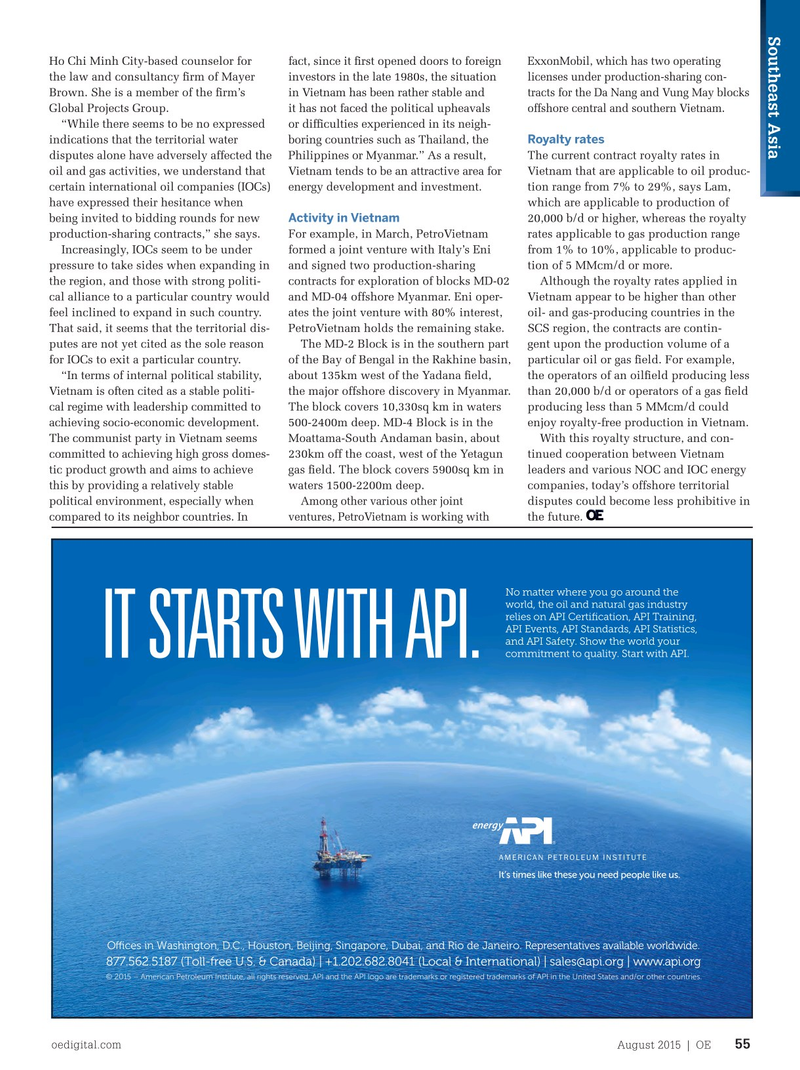
Page 53: of Offshore Engineer Magazine (Aug/Sep 2015)
Read this page in Pdf, Flash or Html5 edition of Aug/Sep 2015 Offshore Engineer Magazine
Southeast Asia
Ho Chi Minh City-based counselor for fact, since it frst opened doors to foreign
ExxonMobil, which has two operating the law and consultancy frm of Mayer investors in the late 1980s, the situation licenses under production-sharing con-
Brown. She is a member of the frm’s in Vietnam has been rather stable and tracts for the Da Nang and Vung May blocks
Global Projects Group. it has not faced the political upheavals offshore central and southern Vietnam.
“While there seems to be no expressed or diffculties experienced in its neigh-
Royalty rates indications that the territorial water boring countries such as Thailand, the disputes alone have adversely affected the Philippines or Myanmar.” As a result, The current contract royalty rates in oil and gas activities, we understand that Vietnam tends to be an attractive area for Vietnam that are applicable to oil produc- certain international oil companies (IOCs) energy development and investment. tion range from 7% to 29%, says Lam, have expressed their hesitance when which are applicable to production of
Activity in Vietnam being invited to bidding rounds for new 20,000 b/d or higher, whereas the royalty hydrocarbon potential, production-sharing contracts,” she says. For example, in March, PetroVietnam rates applicable to gas production range these countries are signif- Increasingly, IOCs seem to be under formed a joint venture with Italy’s Eni from 1% to 10%, applicable to produc- cantly driven to invest in pressure to take sides when expanding in and signed two production-sharing tion of 5 MMcm/d or more. offshore production, tech- the region, and those with strong politi- contracts for exploration of blocks MD-02 Although the royalty rates applied in nology, pipeline networks cal alliance to a particular country would and MD-04 offshore Myanmar. Eni oper- Vietnam appear to be higher than other and drilling. Overall, the feel inclined to expand in such country. ates the joint venture with 80% interest, oil- and gas-producing countries in the majority of the countries’ That said, it seems that the territorial dis- PetroVietnam holds the remaining stake. SCS region, the contracts are contin- oil and gas developments putes are not yet cited as the sole reason The MD-2 Block is in the southern part gent upon the production volume of a are found in shallow water for IOCs to exit a particular country. of the Bay of Bengal in the Rakhine basin, particular oil or gas feld. For example, basins because the region “In terms of internal political stability, about 135km west of the Yadana feld, the operators of an oilfeld producing less has seen limited exploration Vietnam is often cited as a stable politi- the major offshore discovery in Myanmar. than 20,000 b/d or operators of a gas feld of deepwater areas, mostly cal regime with leadership committed to The block covers 10,330sq km in waters producing less than 5 MMcm/d could due to a lack of capabilities. achieving socio-economic development. 500-2400m deep. MD-4 Block is in the enjoy royalty-free production in Vietnam.
Yet, more recently, fnds The communist party in Vietnam seems Moattama-South Andaman basin, about With this royalty structure, and con- such as China’s Liwan 3-1 committed to achieving high gross domes- 230km off the coast, west of the Yetagun tinued cooperation between Vietnam gas feld, discovered in 2006, tic product growth and aims to achieve gas feld. The block covers 5900sq km in leaders and various NOC and IOC energy demonstrate the potential of this by providing a relatively stable waters 1500-2200m deep. companies, today’s offshore territorial
Among other various other joint deepwater exploration. As political environment, especially when disputes could become less prohibitive in ventures, PetroVietnam is working with a result, some countries compared to its neighbor countries. In the future. have opted to cooperate in the SCS, such as the part- nership between Malaysia and Brunei to explore off-
No matter where you go around the shore Brunei waters, and the world, the oil and natural gas industry agreement of Thailand and relies on API Certifcation, API Training,
Vietnam to jointly devel-
API Events, API Standards, API Statistics, and API Safety. Show the world your oped areas of the Gulf of Thailand, despite commitment to quality. Start with API.
IT STARTS WITH API.
ongoing territorial disputes.
These success cases contrast with areas of the SCS contested by multiple coun- tries, where such areas have undergone scarce energy development. Differences in political conditions, royalty rates and territorial water disputes continue to interfere with hydrocarbon developments.
Vietnam issues
While SCS territorial offshore disputes continue, and despite the Haiyang
Shiyou 981 Standoff, Vietnam can be seen as an example of movement toward
It’s times like these you need people like us.
international cooperation. However, this was not always the case.
“The escalation of territorial disputes in the South China Sea — which the
Vietnamese call the East Sea — have
Ofces in Washington, D.C., Houston, Beijing, Singapore, Dubai, and Rio de Janeiro. Representatives available worldwide.
been causing great concerns for the 877.562.5187 (Toll-free U.S. & Canada) | +1.202.682.8041 (Local & International) | [email protected] | www.api.org
Vietnamese government and interna- © 2015 – American Petroleum Institute, all rights reserved. API and the API logo are trademarks or registered trademarks of API in the United States and/or other countries.
tional oil and gas companies that have been exploring oil and gas opportunities in Vietnam,” says Quynh-Anh Lam, a 2015_OE_HalfPage_StartsWithAPIAd.indd 1 3/23/15 12:47 PM oedigital.com August 2015 | OE 55 054_OE0815_Geofocus2_Jeannie.indd 55 7/21/15 10:17 PM

 52
52

 54
54